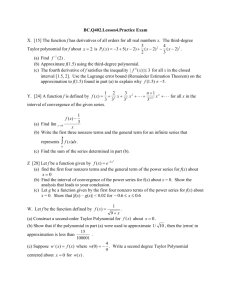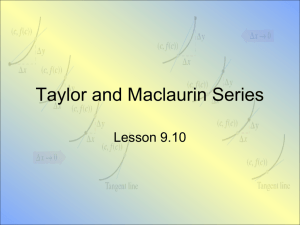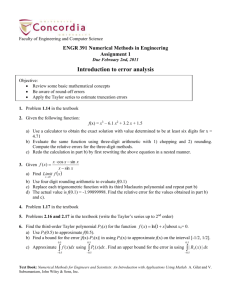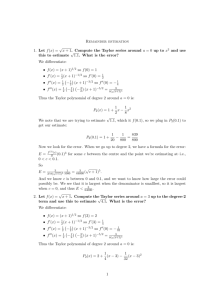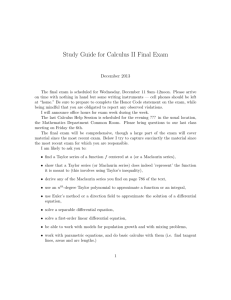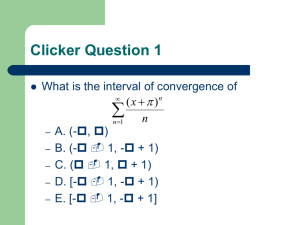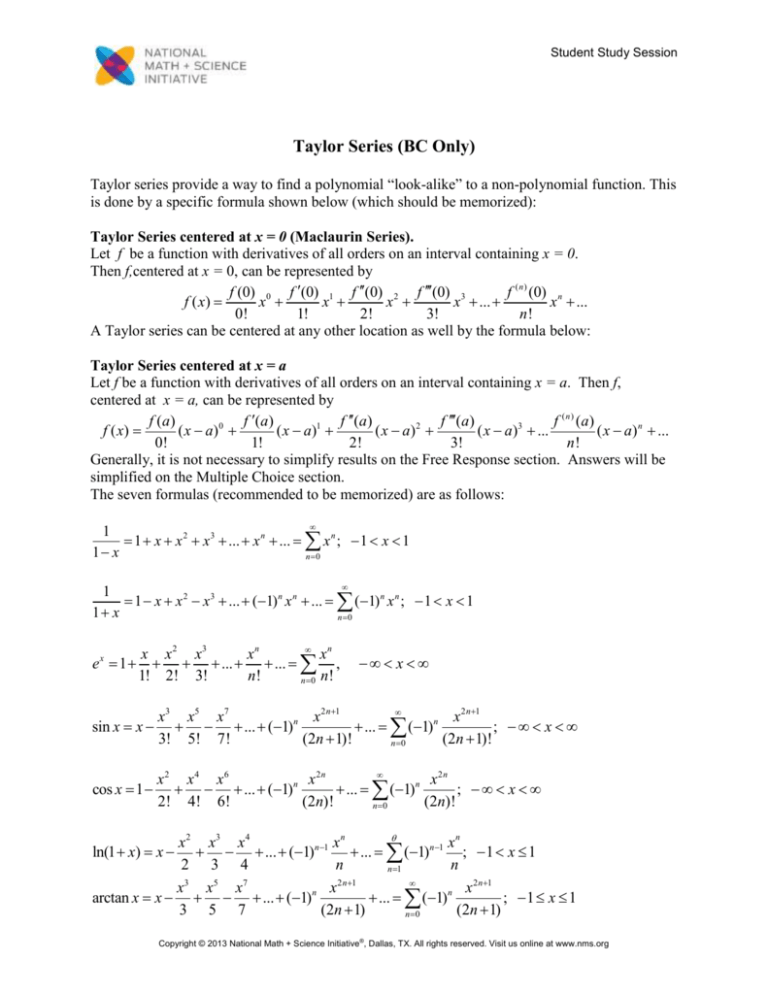
Student Study Session
Taylor Series (BC Only)
Taylor series provide a way to find a polynomial “look-alike” to a non-polynomial function. This
is done by a specific formula shown below (which should be memorized):
Taylor Series centered at x = 0 (Maclaurin Series).
Let f be a function with derivatives of all orders on an interval containing x = 0.
Then f,centered at x = 0, can be represented by
f (0) 0 f (0) 1 f (0) 2 f (0) 3
f ( n ) (0) n
f ( x)
x
x
x
x ...
x ...
0!
1!
2!
3!
n!
A Taylor series can be centered at any other location as well by the formula below:
Taylor Series centered at x = a
Let f be a function with derivatives of all orders on an interval containing x = a. Then f,
centered at x = a, can be represented by
f (a)
f (a)
f (a)
f (a)
f ( n ) (a)
f ( x)
( x a) 0
( x a)1
( x a) 2
( x a)3 ...
( x a) n ...
0!
1!
2!
3!
n!
Generally, it is not necessary to simplify results on the Free Response section. Answers will be
simplified on the Multiple Choice section.
The seven formulas (recommended to be memorized) are as follows:
1
1 x x 2 x3 ... x n ... x n ; 1 x 1
1 x
n 0
1
1 x x 2 x3 ... (1) n x n ... (1) n x n ; 1 x 1
1 x
n 0
x x 2 x3
xn
xn
e 1 ... ... ,
1! 2! 3!
n!
n 0 n !
x
sin x x
x
x3 x5 x 7
x2 n1
x2 n1
... (1)n
... (1)n
; x
3! 5! 7!
(2n 1)!
(2n 1)!
n 0
2n
2n
x2 x4 x6
n x
n x
cos x 1 ... (1)
... (1)
; x
2! 4! 6!
(2n)!
(2n)!
n 0
x 2 x3 x 4
xn
xn
... (1)n1 ... (1)n1 ; 1 x 1
2 3 4
n
n
n 1
3
5
7
2 n 1
x x x
x
x 2 n1
arctan x x ... (1)n
... (1)n
; 1 x 1
3 5 7
(2n 1)
(2n 1)
n 0
ln(1 x) x
Copyright © 2013 National Math + Science Initiative®, Dallas, TX. All rights reserved. Visit us online at www.nms.org
Taylor Series (BC only)
Student Study Session
There are three main types of questions asked on the exam:
Write a function in terms of a series
Find an error bound on an nth degree Taylor Polynomial
Find an interval of convergence
Error Bounds
To determine an error bound for a Taylor polynomial, first classify the polynomial as either an alternating
or non-alternating series. Their error bounds are found as follows:
Alternating Series
When a series is alternating, the error is maximized in the next unused term evaluated at the difference
between the center of the convergence and the x-coordinate being evaluated.
Non-Alternating Series
If a series is non-alternating, the error is still tied up in the next term by the formula
f n 1 ( z )
Error
x a ) n 1 where f ( n 1) ( z ) is the maximum value that the (n+1) derivative can
(n 1)!
take on the interval.
Interval of Convergence for Taylor Series
When looking for the interval of convergence for a Taylor Series, refer back to the interval of
convergence for each of the basic Taylor Series formulas. Fit your function to the function being tested.
Sometimes, the exam will manipulate a Taylor series to a power series before asking for the interval of
convergence. The most common test to find the interval of convergence for a power series is the Ratio
a
Test, which says that lim n1 L . If L <1, the series converges. If L > 1, the series diverges. If L = 1,
n a
n
the test fails and another test should be used. When using the Ratio Test, it is important to remember that
the Ratio Test only checks the open interval. The endpoints of the interval must be checked separately to
determine if the interval is open or closed. If a series is known to be geometric, the endpoints do not need
to be checked since convergence requires r 1 - therefore the endpoints cannot be included.
Copyright © 2013 National Math + Science Initiative®, Dallas, TX. All rights reserved. Visit us online at www.nms.org
Taylor Series (BC only)
Student Study Session
Multiple Choice
1. (calculator not allowed)
Let f be the function given by f ( x) ln(3 x) . The third-degree Taylor polynomial for f about
x 2 is
(A)
(B)
( x 2) 2 ( x 2)3
2
3
2
( x 2) ( x 2)3
( x 2)
2
3
( x 2)
(C)
( x 2) ( x 2)2 ( x 2)3
(D)
( x 2)
(E)
( x 2)2 ( x 2)3
2
3
2
( x 2) ( x 2)3
( x 2)
2
3
2. (calculator not allowed)
What is the polynomial approximation for the value of sin 1 obtained by using the fifth-degree Taylor
polynomial about x 0 for sin x ?
1 1
2 24
1 1
(B) 1
2 4
1 1
(C) 1
3 5
1 1
(D) 1
4 8
1
1
(E) 1
6 120
(A) 1
Copyright © 2013 National Math + Science Initiative®, Dallas, TX. All rights reserved. Visit us online at www.nms.org
Taylor Series (BC only)
Student Study Session
3. (calculator not allowed)
What is the coefficient of x 2 in the Taylor series for
(A)
(B)
(C)
(D)
(E)
1
1 x
2
about x 0?
1
6
1
3
1
3
6
4. (calculator not allowed)
If f ( x) x sin(2 x), which of the following is the Taylor series for f about x 0?
(A)
(B)
(C)
(D)
(E)
x3 x5 x 7
...
2! 4! 6!
4 x3 16 x5 64 x 7
x
...
2!
4!
6!
8 x3 32 x5 128 x 7
2x
...
3!
5!
7!
2 x 4 2 x 6 2 x8
2x2
...
3!
5!
7!
8 x 4 32 x 6 128 x8
2 x2
...
3!
5!
7!
x
Copyright © 2013 National Math + Science Initiative®, Dallas, TX. All rights reserved. Visit us online at www.nms.org
Taylor Series (BC only)
Student Study Session
5. (calculator not allowed)
A function f has Maclaurin series given by
x 4 x5 x 6
x n 3
...
... . Which of the following
2! 3! 4!
(n 1)!
is an expression for f ( x) ?
(A)
(B)
(C)
(D)
(E)
3x sin x 3 x 2
cos( x 2 ) 1
x 2 cos x x 2
x 2e x x3 x 2
ex x2 1
2
6. (calculator allowed)
Let P( x) 3x 2 5x3 7 x 4 3x5 be the fifth-degree Taylor polynomial for the function f about x.
What is the value of f (0) ?
(A)
(B)
(C)
30
15
5
(D)
(E)
5
6
1
6
7. (calculator allowed)
Let f be a function with f (3) 2, f (3) 1, f (3) 6, and f (3) 12. Which of the following is
the third-degree Taylor polynomial for f about x 3?
(A)
2 ( x 3) 3( x 3)2 2( x 3)3
2 ( x 3) 3( x 3)2 4( x 3)3
(C) 2 ( x 3) 6( x 3)2 12( x 3)3
(D) 2 x 3 x 2 2 x 3
(E) 2 x 6 x 2 12 x 3
(B)
Copyright © 2013 National Math + Science Initiative®, Dallas, TX. All rights reserved. Visit us online at www.nms.org
Taylor Series (BC only)
Student Study Session
Free Response
8. (calculator allowed)
x
h( x )
h( x)
h( x )
h( x)
h(4) ( x)
1
11
30
42
99
18
2
80
128
488
3
448
3
584
9
3
317
753
2
1383
4
3483
16
1125
16
Let h be a function having derivatives of all orders for x 0. Selected values for h and its first four
derivatives are indicated in the table above. The function h and these four derivatives are increasing
on the interval 1 x 3.
(a)
Write the first degree Taylor polynomial for h about x = 2 and use it to approximate h(1.9). Is
this approximation greater or less than h(1.9) ? Explain your answer.
(b)
Write the third-degree Taylor polynomial for h about x = 2 and use it to approximate h(1.9).
(c)
Use the Lagrange error bound to show that the third-degree Taylor polynomial for h about
x 2 approximates h(1.9) with an error less than 3 104.
Copyright © 2013 National Math + Science Initiative®, Dallas, TX. All rights reserved. Visit us online at www.nms.org
Taylor Series (BC only)
Student Study Session
9. (calculator not allowed)
Let f be the function given by f ( x) e x .
2
(a) Write the first four nonzero terms and the general term of the Taylor series for f about x = 0.
1 x 2 f ( x)
.
(b) Use your answer from part (a) to find lim
x 0
x4
Copyright © 2013 National Math + Science Initiative®, Dallas, TX. All rights reserved. Visit us online at www.nms.org
Taylor Series (BC only)
Student Study Session
(c)
Write the first four nonzero terms of the Taylor Series for
your answer to estimate
ò
1/2
0
e
-t 2
ò
x
0
e -t dt . Use the first two terms of
2
dt .
(d) Explain why the estimate found in part (c) differs from the actual value of
than
1
0
2
e t dt by less
2
1
.
200
Copyright © 2013 National Math + Science Initiative®, Dallas, TX. All rights reserved. Visit us online at www.nms.org
Taylor Series (BC only)
Student Study Session
10. (calculator not allowed)
Let f be a function with derivatives of all orders and for which f(2) = 7. When n is odd, the nth
derivative of f at x = 2 is 0. When n is even and n > 2, the nth derivative at x = 2 is given by
(n 1)!
f ( n ) (2)
.
3n
(a) Write the sixth-degree Taylor polynomial for f about x = 2.
(b)
In the Taylor series for f about x = 2, what is the coefficient of ( x 2)2 n for n 1?
(c)
Find the interval of convergence of the Taylor series for f about x = 2. Show the work that
leads to your answer.
Copyright © 2013 National Math + Science Initiative®, Dallas, TX. All rights reserved. Visit us online at www.nms.org
Taylor Series (BC only)
Student Study Session
11. (calculator not allowed)
The function f is defined by f ( x)
1 x3 x 6 x9
1
. The Maclaurin series for f is given by
1 x3
1 x3n
n
,
which converges to f ( x) for 1 x 1 .
(a)
Find the first three nonzero terms and the general term for the Maclaurin series for f ( x )
(b)
Use your results from part (a) to find the sum of the infinite series
.
(c)
3 6 9
22 25 28
n
3n
23n 1
.
Find the first four nonzero terms and the general term for the Maclaurin series
representing
(d)
1
x
0
f (t ) dt .
Use the first three nonzero terms of the infinite series found in part (c) to approximate
1/ 2
0
f (t ) dt . What are the properties of the terms of the series representing
that guarantee that this approximation is within
1/ 2
0
f (t ) dt
1
of the exact value of the integral?
10, 000
Copyright © 2013 National Math + Science Initiative®, Dallas, TX. All rights reserved. Visit us online at www.nms.org
Taylor Series (BC only)
Student Study Session
12. (calculator not allowed)
Let f be the function given by f ( x) 6e x / 3 for all x.
(a)
Find the first four nonzero terms and the general term for the Taylor series for f about x = 0.
(b)
Let g be the function given by g ( x)
x
f (t ) dt . Find the first four nonzero terms and the
0
general term for the Taylor series for g about x = 0
(c)
The function h satisfies h( x) k f (ax) for all x, where a and k are constants. The Taylor series
for h about x = 0 is given by
h( x ) 1 x
x 2 x3
2! 3!
xn
n!
.
Find the values of a and k.
Copyright © 2013 National Math + Science Initiative®, Dallas, TX. All rights reserved. Visit us online at www.nms.org

